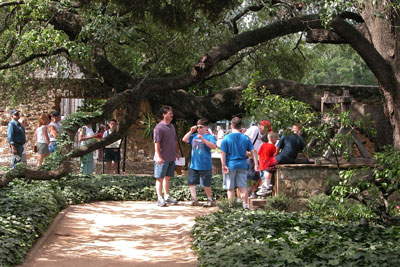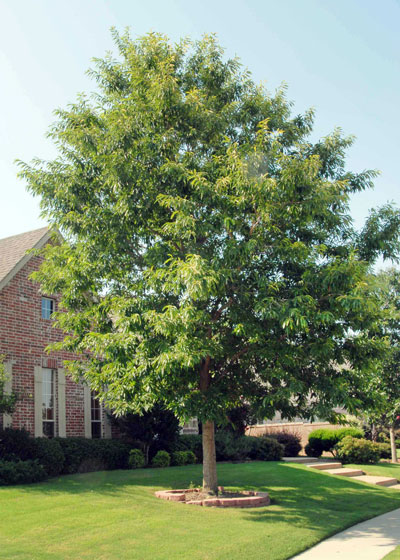Critical Factors in Tree Selection
High quality shade trees properly placed and cared for can add thousands of dollars of value to your property. These are the most important things you’ll want to consider.

Photo: Live oak planted on grounds of the Alamo almost 100 years ago shows eventual mature size of this magnificent species. It’s definitely not for small city lots.
• Mature size. Do your homework ahead of time. Ask the nurseryman how tall and how wide each species will grow so you’ll be able to make informed decisions. If you’re careless at this point, you could end up with shade trees growing into adjoining trees, rubbing the roof of your house or even interfering with power lines.
• Growth form. Odds are that you’ve never given a tree’s growth form (shape) much consideration, but it’s a really important plant feature. How the tree grows does a lot toward determining the message it brings to its surroundings. Rounded and oval-shaped trees are visually restful. Vertical and columnar trees are much less so. In most cases, growth form is genetically pre-determined. You can’t change it with pruning shears, so choose your trees carefully.
• Appearance. Ugly trees take just as much water and fertilizer as handsome ones. You’re the one making this choice, and it only makes sense to choose a tree that will bring you pride years down the road.
• Adaptability. Simply put, to be a good member of your family, a tree has to be willing to cooperate. Just like any other invited guest to your home, it needs to be able to prosper with what you can provide for it. Your tree needs to be able to withstand local winters and summers, rain and drought. It must be suited to your soils, because you can’t bring in enough dump trucks of soil to support the massive root system of a mature shade tree.
• Longevity. Enjoy digging holes and planting new trees? Probably not, and that’s precisely why you should invest in trees that will live for 50, 100 and even more years. Stay away from the fast growing “trash” trees that flame out after 5 or 10 years. Fast growth is a terrible criterion to use in the selection of your new trees.

Photo: Chinquapin oak, native to portions of the central third of the state, matures into a large, rounded tree that will live 100-150 years with few pest problems. It’s a lovely addition to any Texas landscape.
• Freedom from pests and other problems. The best two ways to avoid ending up with a crybaby shade tree are to do your homework ahead of time by reading everything printed and online about the tree you’re considering, and also to ask the nurseryman just before you plunk down your cash, “Is there anything I need to know about this tree I’m about to buy? Any fatal flaws it’s likely to encounter?” Let them own a part of your tree-buying decisions.
